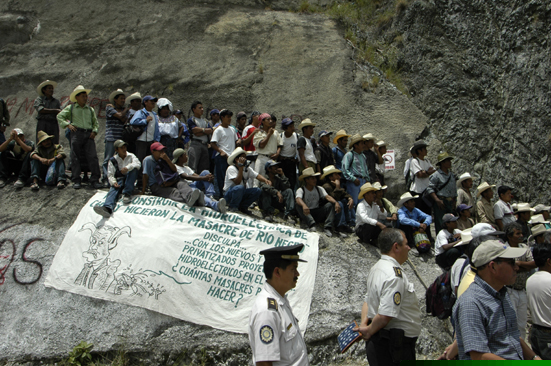In July of 2003, Asociacion Campesina Río Negro 13 de Marzo Maya Achi (ASCRA) — and their advocates (International Rivers Network, Rights Action and the Campaign for the Reform of the World Bank), commissioned research in support of a reparations plan with the Center for Political Ecology, California, USA. The investigation conducted by CEP is comprised of five components: critical review of the documentary record, household survey and consequential damage assessment, the social investigation of the communities affected by the Chixoy Dam, and a cadastre and land registry of affected lands. This five-volume study, completed in March 2005, represents an independent, transparent, peer-reviewed assessment of Chixoy Dam development history, consequential damages, and community needs, and includes findings, recommendations, and a plan for reparation. These documents were submitted to the InterAmerican Human Rights Court in support of petitions filed by Rio Negro Massacre Survivors, and were accepted by the government of Guatemala as one of three core statements of damage in a reparations negotiation process that culminated in a 2010 signed agreement between affected communities and the Government of Guatemala in a reparation negotiation facilitated by the InterAmerican Human Rights Commission and witnessed by representatives of the World Bank and Inter-American Development Bank.
The Chixoy Dam was financed by the World Bank, Inter-American Development Bank and other international institutions at a time when state-sponsored violence against its indigenous citizens was widely reported. The history of violence and massacres accompanying Chixoy Dam development received international media attention in spring 2013, with the highly publicized genocide trial of former dictator General Rios Montt and the related questions: Who financed these crimes against humanity? Who profited? And what remaining obligations exist to provide meaningful redress to victims and their families? At the height of the genocide, the sole source of funding for the military Government was achieved through internationally-financed hydro-development.
Concern for the unaddressed legacy issues of Guatemala’s civil war, and specific concern for the failure to achieve reparation in the Chixoy Dam case drew renewed political attention in the US to these issues. In January 2014, the United States Congress passed compromise legislation on the annual budget. Buried within its’ 1500+ pages is specific and far-reaching language that clarifies US obligations and related policy with regards to public funds invested in foreign contexts, including US investment in international financial institutions.
Specifically, international financial institutions (IFIs) must ensure that a negotiated reparation agreement between the Government of Guatemala and communities affected by Chixoy Dam construction, forced displacements, and related violence is fully implemented; take demonstrative measures to ensure similar compliance to reparation agreements between residents of Boeung Kak lake in Cambodia and the Cambodian government; and, oppose financing for any activities that involve forced evictions or other violations of human rights in Ethiopia. This law also requires US representatives at IFIs to vote against “any financing to support or promote the expansion of industrial scale logging or any other industrial scale extractive activity into areas that were primary/intact tropical forest as of December 30, 2013” and any loan, grant, strategy or policy of such institution to support the construction of any large hydroelectric dam (as defined in “Dams and Development: A New Framework for Decision-Making (World Commission on Dams, 2000).” IFIs are also required to undertake independent outside evaluations of all of its lending to ensure that each institution “responds to the findings and recommendations of its accountability mechanisms by providing just compensation or other appropriate redress to individuals and communities that suffer violations of human rights.”
This language was originally introduced as part of the Foreign Appropriations bill adopted by the Senate in the spring 0f 2013, following a series of meetings with representatives of affected communities, IFI staff, civil society advocates, and input from independent experts such as myself. Documentary evidence submitted in support of Senate deliberations demonstrated IFI failures to attend to the recommendations of internal and external compliance mechanisms and, thus, an unmet IFI obligation with regards to continuing human rights abuse.
_______________________________________________________________________________
The Chixoy Dam Legacy Issues Study may be freely duplicated or linked to for nonprofit research, advocacy, and education purposes. Downloads are in PDF format (requires free Adobe Acrobat Reader).
-
Volume 1: Executive Summary: Consequential Damages and Reparation — Recommendations for Remedy, CPE/BRJohnston.
>> Download in English: chixoyvol1eng
>> Transferencia Directa en Español: chixoyvol1espan -
Volume 2: Document Review and Chronology of Relevant Actions and Events,CPE/BRJohnston.
>> Download in English: chixoyvol2eng
>> Transferencia Directa en Español: chixoyvol2espan -
Volume 3: Consequential Damage Assessment of Chixoy River Basin Communities, CPE/BRJohnston.
>> Download in English: chixoyvol2espan
>> Transferencia Directa en Español: chixoyvol3espan -
Volume 4: Investigación Social de Comunidades Afectadas por la Represa Chixoy, Rights Action/Monti Aguirre, Annie Bird.
>> Download in English: chixoyvol4eng
>> Transferencia Directa en Español: chixoyvol4espanLowRes -
Volume 5: Estudio Histórico, Catastral, Registral Y Geográfico de las Comunidades Afectadas Por La Inundación Provocada Por La Construcción De La Presa Pueblo Viejo-Quixal, Sobre El Río Negro O Chixoy, Diego Martinez Estrada.
>> Transferencia Directa en Español: chixoyvol5espan

One thought on “Chixoy Dam Legacy Issues Study”
Comments are closed.